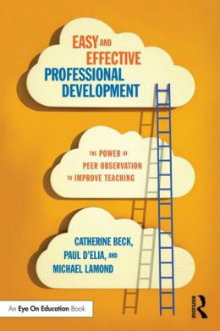Harness the Experts Inside the School
Easy and Effective Professional Development: the Power of Peer Observation to Improve Teaching
By Catherine Beck, Paul D’Elia and Michael Lamond
(Routledge, 2015 – Learn more)

Easy and Effective Professional Development has a couple of basic premises that are hard for an educator not to get behind: 1) Teachers are experts, and professionals as well. 2) Every school has a wealth of resources for its professional development, within its own walls.
These are the two start points of this potentially very helpful little book by Beck, D’Elia and Lamond. “Potentially,” because the program described by them needs to be a campus-wide commitment for it to be of value. As described and ascribed, it is hard not to want to try it, however.
Teaming to share expertise
The authors are proponents of what they refer to the Peer Observation Process (POP). It is proposed as an inexpensive professional development alternative – one that also builds a culture of supportive collegiality as a corollary benefit.

The authors cite multiple studies that support this approach: teachers observing teachers is “beneficial to both the observed and the observer;” moreover, a “bidirectional learning experience” is achieved.” (p. 15)
POP needs to be evaluation-free
Clearly, there is more to POP than just that process. The authors stress that it must be non-evaluative. The majority of teachers seldom have the benefit of another adult in the classroom, except when an administrator steps in for an annual evaluation. The POP is intended to provide feedback to teachers, by teachers – and (just as important) by teachers familiar with the same student population.
Feedback is something we classroom teachers sorely lack; this process has the potential to fill a massive gap. For it to work, though, it needs to be constructive rather than judgmental. The book discusses many key factors in the implementation of such a program that can help to achieve that.
Using POP for approved professional development
Another aspect is the Professional Development side of this. Each district will have a different method by which campus PD will be chosen and approved. In some instances, a principal’s stamp will be sufficient; in others, the superintendent or even school board may have to approve the program and its agreed hours and requirements.
Early on in the book, the authors observe that standards “have taken care of the ‘what’ leaving the ‘how’ as the important implementation step.” (p. 5) For instructional specialists to form their own professional learning communities on campus to meet this need seems ideal; for the program to fulfill requirements for professional development, perhaps as pedagogical best learning practices, is even better.
Many districts are taking the step of adding curriculum coaches or specialists to their staff, or hiring in trainers. The POP is an alternative, less costly step. It assumes the expertise of the teaching staff — why not put faith in them,and draw on that expertise?
POP will need to be customized
The authors use the experiences of three schools– a rural high school, a dual language elementary, and an inner city middle school – to describe and recommend the process. Each had its own set of challenges and its own problems. Each achieved notable improvements in the areas of test scores, culture, and professionalism. (p. 45)
The authors point out that implementation in any school will need its own customization– meeting times, observation scheduling, even the level of administrative involvement. (The book strongly recommends that the building principal not be directly involved to maintain the non-evaluative nature of the process, but this might not be realistic if this is to count toward PD.)
To achieve real success, commitment needs to be lasting; while improvements were seen in the first years among schools using POP, bigger changes were clear in subsequent years
The book makes a strong case
I would strongly recommend this book to any educator who is seriously interested in trying the Peer Observation Process out, whether teacher or administrator. The book makes a very strong case for using the process; it also gives detailed recommendations for implementing the practice in a school, as well as templates for observation checklists and user surveys.
I chose to read this book because the idea of such a program had occurred to me as a voluntary campus resource for classroom teachers. Now I am even more convinced and intend to approach my principal about running a closed trial with a few others, before trying it as a campus wide program in the future.
The biggest success of using the program may well be the shift in professionalism and morale described throughout the book. Classroom teachers felt more part of a professional community than cog in the machine. Moreover, their enthusiasm, pride and sense of collegiality increased, and this was true for both new and veteran teachers. The sort of positive school culture that exists when these factors are present is its own priceless resource.
Dina Murphy teaches seventh grade Math at West Brazos Junior High in Brazoria, Texas. Despite having planned to teach Social Studies, she enjoys the challenges of helping students learn to share her love of math. Dina and her 7th grade math team partner are happily embracing technology in their classrooms, and have set themselves a high learning curve in order to offer their students a strong math curriculum that also gives them a good base in 21st century communication and work technology.




































I agree – Give your teachers a hall pass! http://scan-werecriticaltothinking.blogspot.com/2013/03/give-your-teachers-hall-pass.html